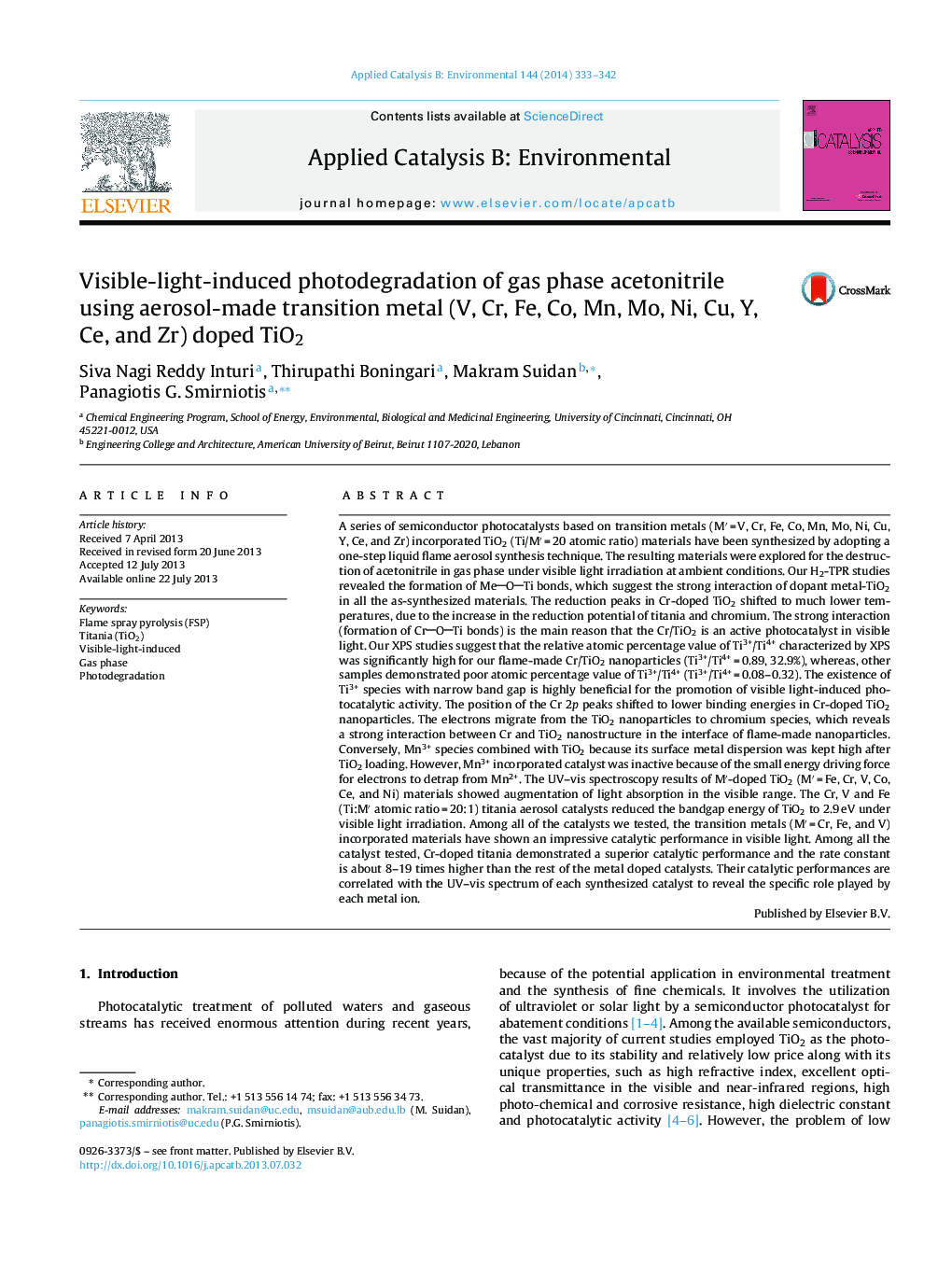| کد مقاله | کد نشریه | سال انتشار | مقاله انگلیسی | نسخه تمام متن |
|---|---|---|---|---|
| 45368 | 46410 | 2014 | 10 صفحه PDF | دانلود رایگان |

• Aerosol metal-doped TiO2 nanoparticles for the visible light-induced photocatalysis.
• Doping of TiO2 with Cr, V, and Fe (Ti/M′ = 20) aerosol catalyst reduced bandgap energy.
• ACN degradation reactions follow pseudo first order Langmuir Hinshelwood kinetics.
• Cr-doped TiO2 shows comparatively higher rate constant than other catalysts.
• Significantly high relative atomic percentage of Ti3+/Ti4+ for Cr/TiO2 nanoparticles.
A series of semiconductor photocatalysts based on transition metals (M′ = V, Cr, Fe, Co, Mn, Mo, Ni, Cu, Y, Ce, and Zr) incorporated TiO2 (Ti/M′ = 20 atomic ratio) materials have been synthesized by adopting a one-step liquid flame aerosol synthesis technique. The resulting materials were explored for the destruction of acetonitrile in gas phase under visible light irradiation at ambient conditions. Our H2-TPR studies revealed the formation of MeOTi bonds, which suggest the strong interaction of dopant metal-TiO2 in all the as-synthesized materials. The reduction peaks in Cr-doped TiO2 shifted to much lower temperatures, due to the increase in the reduction potential of titania and chromium. The strong interaction (formation of CrOTi bonds) is the main reason that the Cr/TiO2 is an active photocatalyst in visible light. Our XPS studies suggest that the relative atomic percentage value of Ti3+/Ti4+ characterized by XPS was significantly high for our flame-made Cr/TiO2 nanoparticles (Ti3+/Ti4+ = 0.89, 32.9%), whereas, other samples demonstrated poor atomic percentage value of Ti3+/Ti4+ (Ti3+/Ti4+ = 0.08–0.32). The existence of Ti3+ species with narrow band gap is highly beneficial for the promotion of visible light-induced photocatalytic activity. The position of the Cr 2p peaks shifted to lower binding energies in Cr-doped TiO2 nanoparticles. The electrons migrate from the TiO2 nanoparticles to chromium species, which reveals a strong interaction between Cr and TiO2 nanostructure in the interface of flame-made nanoparticles. Conversely, Mn3+ species combined with TiO2 because its surface metal dispersion was kept high after TiO2 loading. However, Mn3+ incorporated catalyst was inactive because of the small energy driving force for electrons to detrap from Mn2+. The UV–vis spectroscopy results of M′-doped TiO2 (M′ = Fe, Cr, V, Co, Ce, and Ni) materials showed augmentation of light absorption in the visible range. The Cr, V and Fe (Ti:M′ atomic ratio = 20:1) titania aerosol catalysts reduced the bandgap energy of TiO2 to 2.9 eV under visible light irradiation. Among all of the catalysts we tested, the transition metals (M′ = Cr, Fe, and V) incorporated materials have shown an impressive catalytic performance in visible light. Among all the catalyst tested, Cr-doped titania demonstrated a superior catalytic performance and the rate constant is about 8–19 times higher than the rest of the metal doped catalysts. Their catalytic performances are correlated with the UV–vis spectrum of each synthesized catalyst to reveal the specific role played by each metal ion.
Figure optionsDownload as PowerPoint slide
Journal: Applied Catalysis B: Environmental - Volume 144, January 2014, Pages 333–342